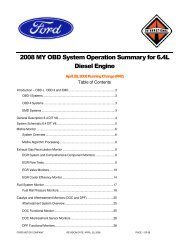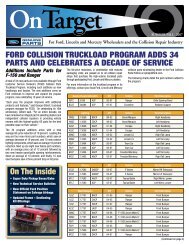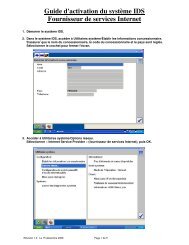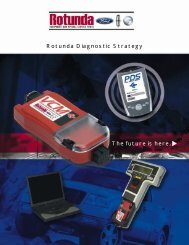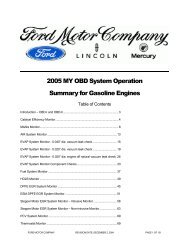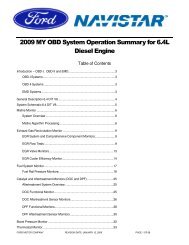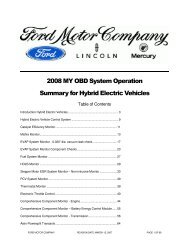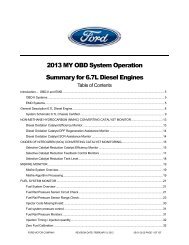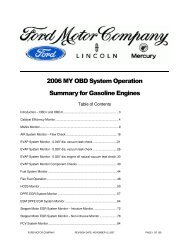2005 MY OBD System Operation Summary for Gasoline Engines
2005 MY OBD System Operation Summary for Gasoline Engines
2005 MY OBD System Operation Summary for Gasoline Engines
Create successful ePaper yourself
Turn your PDF publications into a flip-book with our unique Google optimized e-Paper software.
There are three different misfire monitoring technologies used in the <strong>2005</strong> <strong>MY</strong>. They are Low Data Rate (LDR),High Data Rate (HDR), and Neural Network Misfire(NNM). The LDR system is capable of meeting the FTPmonitoring requirements on most engines and is capable of meeting “full-range” misfire monitoring requirementson 4-cylinder engines. The HDR system is capable of meeting “full-range” misfire monitoring requirements on 6and 8 cylinder engines, but not on V-10 or V-12 engines. Neural Network Misfire detection is being piloted on the6.8L V-10 in order to achieve "full-range" capability. All software allows <strong>for</strong> detection of any misfires that occur 6engine revolutions after initially cranking the engine. This meets the new <strong>OBD</strong>-II requirement to identify misfireswithin 2 engine revolutions after exceeding the warm drive, idle rpm.," $The LDR Misfire Monitor uses a low-data-rate crankshaft position signal, (i.e. one position reference signal at 10deg BTDC <strong>for</strong> each cylinder event). The PCM calculates crankshaft rotational velocity <strong>for</strong> each cylinder from thiscrankshaft position signal. The acceleration <strong>for</strong> each cylinder can then be calculated using successive velocityvalues. The changes in overall engine rpm are removed by subtracting the median engine acceleration over acomplete engine cycle. The resulting deviant cylinder acceleration values are used in evaluating misfire in the“General Misfire Algorithm Processing” section below.“Profile correction” software is used to “learn” and correct <strong>for</strong> mechanical inaccuracies in crankshaft tooth spacingunder de-fueled engine conditions (requires three 60 to 40 mph no-braking decels after Keep Alive Memory hasbeen reset). These learned corrections improve the high-rpm capability of the monitor <strong>for</strong> most engines. Themisfire monitor is not active until a profile has been learned.-# $The HDR Misfire Monitor uses a high data rate crankshaft position signal, (i.e. 18 position references percrankshaft revolution [20 on a V-10]). This high-resolution signal is processed using two different algorithms. Thefirst algorithm, called pattern cancellation, is optimized to detect low rates of misfire. The algorithm learns thenormal pattern of cylinder accelerations from the mostly good firing events and is then able to accurately detectdeviations from that pattern. The second algorithm is optimized to detect “hard” misfires, i.e. one or morecontinuously misfiring cylinders. This algorithm filters the high-resolution crankshaft velocity signal to remove someof the crankshaft torsional vibrations that degrade signal to noise. This significantly improves detection capability <strong>for</strong>continuous misfires. Both algorithms produce a deviant cylinder acceleration value, which is used in evaluatingmisfire in the “General Misfire Algorithm Processing” section below.Due to the high data processing requirements, the HDR algorithms could not be implemented in the PCMmicroprocessor. They are implemented in a separate chip in the PCM called an “AICE” chip. The PCMmicroprocessor communicates with the AICE chip using a dedicated serial communication link. The output of theAICE chip (the cylinder acceleration values) is sent to the PCM microprocessor <strong>for</strong> additional processing asdescribed below. Lack of serial communication between the AICE chip and the PCM microprocessor, or aninability to synchronize the crank or cam sensors inputs sets a P1309 DTC. For 2004 <strong>MY</strong> software, the P1309DTC is being split into two separate DTCs. A P0606 will be set if there is a lack of serial communication betweenthe AICE chip and the PCM microprocessor. A P1336 will be set if there is an inability to synchronize the crank orcam sensors inputs. This change was made to improve serviceability. A P0606 generally results in PCMreplacement while a P1336 points to a cam sensor that is out of synchronization with the crank.“Profile correction” software is used to “learn” and correct <strong>for</strong> mechanical inaccuracies in crankshaft tooth spacingunder de-fueled engine conditions (requires three 60 to 40 mph no-braking decels after Keep Alive Memory hasbeen reset). If KAM has been reset, the PCM microprocessor initiates a special routine which computes correctionfactors <strong>for</strong> each of the 18 (or 20) position references and sends these correction factors back to the AICE chip tobe used <strong>for</strong> subsequent misfire signal processing. These learned corrections improve the high rpm capability of themonitor. The misfire monitor is not active until a profile has been learned.FORD MOTOR COMPANY REVISION DATE: APRIL 28, 2004 PAGE 8 OF 131



